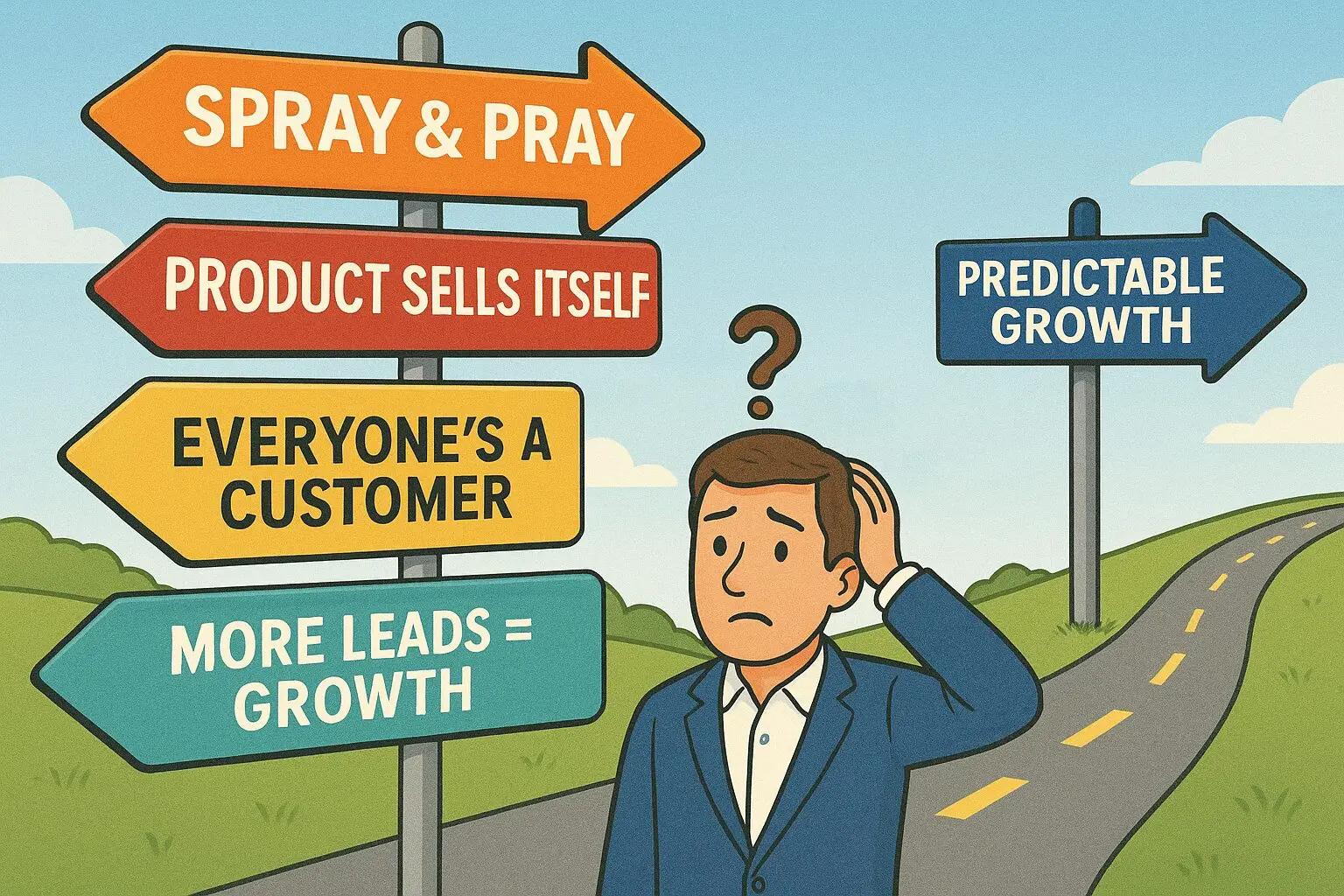- Why Do So Many SaaS Go-to-Market Strategies Fail?
- Do SaaS Products Need Sales?
- How Do You Generate Quality SaaS Leads?
- How Do You Define Your SaaS ICP?
- When Should SaaS Founders Delegate Sales?
- What Is Spray and Pray Marketing?
- How Do You Align SaaS Sales and Marketing?
- What’s the Best GTM Stack for SaaS?
- How Do I Avoid SaaS Go-to-Market Mistakes?
Why Do So Many SaaS Go-to-Market Strategies Fail?
If you’re a SaaS founder, you’ve probably noticed it’s not the product or the effort that causes most startups to stall—it’s the baggage of bad go-to-market advice. Many “conventional wisdoms” are actually Go-To-Market myths that quietly hold you back. Let’s bust them one by one, with a focus on what founders are really asking.
Do SaaS Products Need Sales?
Myth #1: “If the Product Is Great, It Will Sell Itself”
No, even the best SaaS products don’t sell themselves. The belief that “if you build it, they will come” is a comforting myth, but markets are crowded and attention is limited. Successful SaaS founders invest in go-to-market strategy, clear messaging, and direct sales—because value isn’t always obvious to your customer without education and advocacy. Founders who rely on product alone often overlook the importance of narrative.
For a deeper dive into how to connect value with buyers, see Founder Storytelling: Why Human Stories Outperform Feature Lists in B2B.
And if you’re finding that your team is carrying the weight while growth stalls, The Founder Ego Trap: Why Your Sales Won’t Scale Until You Let Go highlights why leadership bottlenecks often hold companies back.
How Do You Generate Quality SaaS Leads?
Myth #2: “Growth = More Leads”
Quality beats quantity every time. Chasing lead volume fills your pipeline with the wrong prospects, wastes sales resources, and leads to miserable conversion rates. In reality, the most successful SaaS teams obsess over attracting and qualifying the right customers—those who have the problem you solve, the willingness to pay, and the ability to grow with you. Founders who focus on lead quality find their pipeline becomes a source of confidence, not chaos.
More isn’t always better. If pipeline confidence is a concern, read Pipeline Coverage for Startups vs Enterprise: Why 3x is a Myth to see why “3x coverage” often misleads SaaS teams.
You can also explore how to uncover hidden customer value with the Out-of-Body Experience framework, which helps shift focus from volume to fit.
How Do You Define Your SaaS ICP?
Myth #3: “Anyone Can Be Our Customer”
Not everyone is a fit. Trying to sell to “anyone with a pulse” leads to diluted messaging, confused sales teams, and unhappy customers. Your Ideal Customer Profile (ICP) should be specific and data-driven: Who are your best customers? What do they value? What’s their buying trigger? The more you focus, the better your win rates, expansion, and retention.
Defining your ICP isn’t optional—it’s the foundation of scale. If you’re still early and unsure who your true buyers are, start with How Do I Figure Out Our Ideal Customer Profile If We Haven’t Sold Much Yet?.
When Should SaaS Founders Delegate Sales?
Myth #4: “The Founder Should Close Every Deal”
Early-stage founders should absolutely be close to the first deals—but founder-led sales can’t scale forever. If you are the only one who can close, you’re building a bottleneck, not a business. The best SaaS founders document what works, train others, and build process so the team can sell without founder heroics. As soon as you can consistently close a type of customer, start training and delegating—your sanity (and valuation) will thank you.
Founder-led sales can’t scale forever. See How Do I Scale Revenue Without Being the One Closing Every Deal as a Founder? for strategies to transition smoothly.
For a perspective on avoiding burnout when you’re still carrying every deal, check out Tired of Carrying Every Deal? How to Escape Founder Burnout for Good.
What Is Spray and Pray Marketing?
Myth #5: “Spray and Pray Marketing Still Works”
“Spray and pray” means sending untargeted emails, running broad ads, or trying every campaign idea at once. The myth is that more noise equals more pipeline, but the reality is it just generates confusion and wastes budget. Effective SaaS marketing is targeted, message-driven, and built around real customer pain points—not random acts of activity. Founders who ditch “spray and pray” in favor of focused, data-driven campaigns see more qualified leads and better ROI.
Random acts of marketing don’t cut it. If you’re still searching for the right structure before product-market fit, see What’s the Right Go-to-Market Strategy for a B2B SaaS Startup Before Product-Market Fit?.
How Do You Align SaaS Sales and Marketing?
Myth #6: “Sales and Marketing Should Work Separately”
Silos kill growth. When sales and marketing work in isolation, you get broken handoffs, lost leads, and the infamous “blame game.” The best SaaS teams align on ICP, collaborate on messaging, set shared targets, and regularly review the pipeline together. Alignment isn’t just a nice-to-have—it’s the difference between compounding growth and endless firefighting.
Alignment between sales and marketing is a growth multiplier. Before you make your first big hire, read Before You Make Your First Sales Hire, Read This for advice on structuring roles that drive collaboration.
What’s the Best GTM Stack for SaaS?
Myth #7: “You Can Fix GTM Problems With Tools Alone”
No technology can save a broken process. SaaS founders often believe that the right CRM, automation, or analytics tool will solve their go-to-market woes. But tools only amplify what’s already working (or broken). If you don’t understand your customer or lack a repeatable process, your tech stack will only help you fail faster. Invest in process and empathy before adding more software to the pile.
Tools amplify process—they don’t replace it. For guidance on building the foundation your tech stack should support, see What Should Go Into a Sales Playbook If We’ve Never Had One Before?.
How Do I Avoid SaaS Go-to-Market Mistakes?
Most SaaS founders run into trouble when they follow the crowd and accept these myths as truth. The real path to scalable growth is to:
- Obsess over your customer’s real problems.
- Build a repeatable, data-driven sales process.
- Align sales and marketing around the same targets.
- Focus on quality over quantity in every part of your funnel.
Every successful SaaS company eventually outgrows these myths—great founders just do it sooner. If you’re tired of unpredictable growth, now’s the time to challenge the old playbook.
Next Step: If you want a blueprint for what leadership structure actually drives results, my Chief Commercial Officer Guide covers the role, responsibilities, and timing of a CCO hire.
Want a shortcut to GTM clarity?
Download The GTM Engine e-book or Book a free GTM audit discovery call and build a strategy that works—no myths, just results.
FAQ: Common SaaS GTM Questions
What are signs your SaaS GTM isn’t working?
Low close ratios, pipeline bloat, founder burnout, or constant “blame game” between teams. For a breakdown of common stall patterns, check out Common Challenges SaaS Teams Face When Scaling.
When should I hire my first sales rep?
Once you have a documented repeatable sales process and can close a consistent ICP, start hiring and training. To avoid common missteps, read How Can I De-Risk My First Sales Leadership Hire?.
How do I transition away from founder-led sales?
Document everything, train others, and let go of the need to “save” every deal yourself. A practical look at this shift is in The Founder Ego Trap.
What metrics matter most?
Qualified pipeline (MQLs/SQLs), win rate (close ratios), Average sales cycle length, CAC payback (CLV to CAC Ratio), and Retention. From these metrics you can map to a revenue target. For a closer look at pipeline math and forecasting, see Pipeline Coverage for Startups vs Enterprise.


Leave a Reply